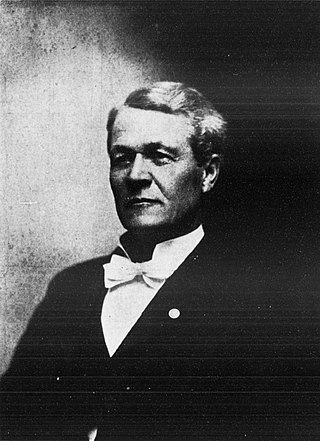| # | Senate President | Term start | Term end | Party | Governor |
|---|
| 1 | |  | John Phelps 1821 – August 26, 1884
(aged 63) | June 20, 1863 | January 19, 1864 | Republican | | Arthur Boreman |
| 2 | |  | William Stevenson March 18, 1820 – November 29, 1883
(aged 63) | January 19, 1864 | January 19, 1869 | Republican |
| 3 | |  | Daniel Farnsworth December 23, 1819 – December 5, 1892
(aged 72) | January 19, 1869 | January 17, 1871 | Republican |
| A. | | | Joseph T. Hoke February 6, 1835 – July 27, 1910
(aged 75) | February 26, 1869 | March 4, 1869 | Republican | | Daniel Farnsworth
(acting) |
| 3 | |  | Daniel Farnsworth December 23, 1819 – December 5, 1892
(aged 72) | January 19, 1869 | January 17, 1871 | Republican | | William Stevenson |
| 4 | |  | Lewis Baker November 11, 1832 – April 30, 1899
(aged 66) | January 17, 1871 | January 16, 1872 | Democratic | |
| John Jacob |
| 5 | |  | Carlos Sperry July 28, 1832 – May 9, 1905
(aged 72) | January 16, 1872 | August 22, 1872 | Democratic |
| 6 | |  | Daniel Johnson April 28, 1836 – December 18, 1893
(aged 57) | November 19, 1872 | January 10, 1877 | Democratic | |
| 7 | |  | Ulysses Arnett November 7, 1820 – December 1, 1880
(aged 60) | January 10, 1877 | January 8, 1879 | Democratic | |
| Henry Mathews |
| 8 | |  | Daniel Johnson April 28, 1836 – December 18, 1893
(aged 57) | January 8, 1879 | January 12, 1881 | Democratic |
| 9 | | | Albert Summers January 1, 1824 – April 1, 1901
(aged 77) | January 12, 1881 | January 10, 1883 | Democratic | |
| Jacob Jackson |
| 10 | | | Thomas Farnsworth May 17, 1829 – October 12, 1916
(aged 87) | January 10, 1883 | January 14, 1885 | Democratic |
| 11 | | | George Price November 9, 1848 – February 6, 1938
(aged 89) | January 14, 1885 | January 9, 1889 | Democratic | |
| Emmanuel Watson |
| 12 | | | Robert Carr November 17, 1845 – May 6, 1925
(aged 79) | January 22, 1889 | January 14, 1891 | Democratic | |
| Aretas Fleming |
| 13 | | | John McCreery July 31, 1845 – May 22, 1917
(aged 71) | January 14, 1891 | January 11, 1893 | Democratic |
| 14 | | | Rankin Wiley April 6, 1853 – February 21, 1929
(aged 75) | January 11, 1893 | January 9, 1895 | Democratic | |
| William MacCorkle |
| 15 | | | William Worley August 1, 1846 – October 7, 1928
(aged 82) | January 9, 1895 | January 13, 1897 | Republican |
| 16 | | | Nelson Whitaker November 9, 1839 – December 28, 1909
(aged 70) | January 13, 1897 | January 11, 1899 | Republican | |
| George Atkinson |
| 17 | |  | Oliver Marshall September 24, 1850 – May 19, 1934
(aged 83) | January 11, 1899 | January 9, 1901 | Republican |
| 18 | | | Anthony Smith January 9, 1844 – July 10, 1927
(aged 83) | January 9, 1901 | January 14, 1903 | Republican | |
| Albert White |
| 19 | | | Clark May July 14, 1869 – April 25, 1908
(aged 38) | January 14, 1903 | January 11, 1905 | Republican |
| 20 | |  | Gustavus Northcott April 4, 1861 – December 8, 1938
(aged 77) | January 11, 1905 | January 9, 1907 | Republican | |
| William Dawson |
| 21 | | | Joseph McDermott July 28, 1871 – December 12, 1930
(aged 59) | January 9, 1907 | January 13, 1909 | Republican |
| 22 | | | Lewis Forman January 7, 1855 – January 3, 1933
(aged 77) | January 13, 1909 | January 11, 1911 | Republican | |
| William Glasscock |
| 23 | | | Robert F. Kidd February 11, 1853 – June 8, 1930
(aged 77) | January 17, 1911 | January 30, 1911 | Democratic |
| 24 | |  | Henry Hatfield September 15, 1875 – October 13, 1962
(aged 87) | January 30, 1911 | January 24, 1913 | Republican |
| 25 | | | Samuel Woods August 31, 1856 – June 1, 1937
(aged 80) | January 24, 1913 | January 13, 1915 | Democratic | |
| Henry Hatfield |
| 26 | |  | Edward England September 29, 1869 – September 9, 1934
(aged 64) | January 13, 1915 | January 10, 1917 | Republican |
| 27 | |  | Wells Goodykoontz June 3, 1872 – March 2, 1944
(aged 71) | January 10, 1917 | January 8, 1919 | Republican | |
| John Cornwell |
| 28 | | | Charles Sinsel June 5, 1864 – December 8, 1923
(aged 59) | January 8, 1919 | January 12, 1921 | Republican |
| 29 | | | Gohen Arnold January 5, 1885 – June 9, 1939
(aged 54) | January 12, 1921 | January 10, 1923 | Republican | |
| Ephraim Morgan |
| 30 | | | Harry Schaffer January 22, 1885 – July 3, 1971
(aged 86) | January 10, 1923 | January 14, 1925 | Republican |
| 31 | | | Charles Coffman August 30, 1875 – August 15, 1929
(aged 53) | January 14, 1925 | April 15, 1925 | Republican |
| 32 | |  | Montezuma White September 6, 1872 – May 10, 1945
(aged 72) | April 15, 1925 | January 11, 1933 | Republican | |
| Howard Gore |
| William Conley |
| 33 | | | Albert Mathews July 31, 1872 – December 5, 1958
(aged 86) | January 11, 1933 | January 9, 1935 | Democratic | |
| Herman Kump |
| 34 | | | Charles Hodges September 27, 1892 – May 1, 1968
(aged 75) | January 9, 1935 | January 11, 1939 | Democratic | |
| Homer Holt |
| 35 | | | William LaFon March 8, 1888 – February 4, 1941
(aged 52) | January 11, 1939 | January 8, 1941 | Democratic |
| 36 | | | Byron Randolph June 12, 1906 – November 7, 1979
(aged 73) | January 8, 1941 | January 13, 1943 | Democratic | | Matthew Neely |
| 37 | | | James Paull May 3, 1901 – March 8, 1983
(aged 81) | January 13, 1943 | January 10, 1945 | Democratic |
| 38 | | | Arnold Vickers August 8, 1908 – December 25, 1967
(aged 59) | January 10, 1945 | January 12, 1949 | Democratic | | Clarence Meadows |
| 39 | | | W. Broughton Johnston May 21, 1905 – August 24, 1978
(aged 73) | January 12, 1949 | January 14, 1953 | Democratic | | Okey Patteson |
| 40 | |  | Ralph Bean December 15, 1912 – June 7, 1978
(aged 65) | January 14, 1953 | January 11, 1961 | Democratic | | William Marland |
| Cecil Underwood |
| 41 | | | Howard Carson April 30, 1910 – August 9, 1994
(aged 84) | January 11, 1961 | January 8, 1969 | Democratic | | Wally Barron |
| Hulett Smith |
| 42 | |  | Lloyd Jackson May 30, 1918 – October 29, 2011
(aged 93) | January 8, 1969 | January 13, 1971 | Democratic | | Arch Moore |
| 43 | |  | E. Hansford McCourt April 21, 1909 – August 3, 1992
(aged 83) | January 13, 1971 | January 10, 1973 | Democratic |
| 44 | | | William Brotherton April 17, 1926 – April 6, 1997
(aged 70) | January 10, 1973 | January 14, 1981 | Democratic | |
| Jay Rockefeller |
| 45 | | | Warren McGraw May 10, 1939 – June 14, 2023
(aged 84) | January 14, 1981 | January 9, 1985 | Democratic |
| 46 | | | Dan Tonkovich April 17, 1946 – February 10, 2002
(aged 55) | January 9, 1985 | January 11, 1989 | Democratic | | Arch Moore |
| 47 | | | Larry Tucker April 11, 1935 – November 16, 2016
(aged 81) | January 11, 1989 | September 7, 1989 | Democratic |
| 48 | | | Keith Burdette
(1955-04-27) April 27, 1955 (age 69) | September 12, 1989 | January 3, 1995 | Democratic | |
| Gaston Caperton |
| 49 | |  | Earl Ray Tomblin
(1952-03-15) March 15, 1952 (age 72) | January 3, 1995 | November 13, 2011 | Democratic | |
| Cecil Underwood |
| Bob Wise |
| Joe Manchin |
| |
| 50 | |  | Jeff Kessler
(1955-11-16) November 16, 1955 (age 68) | November 15, 2010 | November 14, 2011 | Democratic | Earl Ray Tomblin |
| November 14, 2011 | January 14, 2015 |
| 51 | |  | Bill Cole
(1956-05-16) May 16, 1956 (age 67) | January 14, 2015 | January 11, 2017 | Republican |
| 52 | |  | Mitch Carmichael
(1960-04-15) April 15, 1960 (age 64) | January 11, 2017 | January 13, 2021 | Republican | | Jim Justice |
|
| 53 | | | Craig Blair
(1959-10-17) October 17, 1959 (age 64) | January 13, 2021 | Incumbent | Republican |



































